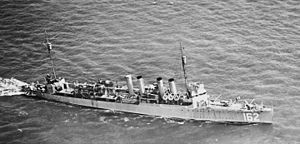USS Thatcher (DD-162)
 USS Thatcher underway, circa 1920
| |
| History | |
|---|---|
| Name | USS Thatcher |
| Namesake | Henry K. Thatcher |
| Builder | Fore River Shipyard, Quincy, Massachusetts |
| Laid down | 8 June 1918 |
| Launched | 31 August 1918 |
| Commissioned | 14 January 1919 |
| Decommissioned | 7 June 1922 |
| Recommissioned | 18 December 1939 |
| Decommissioned | 24 September 1940 |
| Stricken | 8 January 1941 |
| Identification | DD-162 |
| Fate | Transferred to United Kingdom, 24 September 1940 |
| Name | HMCS Niagara |
| Namesake | Niagara River |
| Acquired | 24 September 1940 |
| Decommissioned | 27 May 1946 |
| Identification | Pennant number: I57 |
| Honours and awards | Atlantic 1940-44 |
| Fate | Scrapped 1946 |
| General characteristics | |
| Class and type | Wickes-class destroyer |
| Displacement | 1,191 tons |
| Length | 314 ft 4+1⁄2 in (95.822 m) |
| Beam | 30 ft 11+1⁄4 in (9.430 m) |
| Draft | 9 ft 2 in (2.79 m) |
| Speed | 35 kn (65 km/h; 40 mph) |
| Complement | 122 officers and enlisted |
| Armament |
|

The first USS Thatcher (DD–162) was a Wickes-class destroyer in the United States Navy, later transferred to the Royal Canadian Navy as HMCS Niagara.
Construction and career
Named for Admiral
Following shakedown, Thatcher operated with the
Upon completion of this duty, the destroyer—reclassified as DD-162 on 17 July 1920—resumed her routine training operations off the eastern seaboard before heading west in the autumn of 1921 to join the
Thatcher remained laid-up at San Diego through the summer of 1939. War broke out in Europe on 1 September 1939, when German troops invaded Poland. Thatcher was recommissioned at San Diego on 18 December 1939 and conducted shakedown and training evolutions off the west coast until transferred to the Atlantic the following spring. Transiting the Panama Canal on 1 April 1940, a month before the situation in Europe became critical when Germany began her blitzkrieg against France and the Low Countries, Thatcher subsequently conducted neutrality patrols and training cruises off the east coast and in the Gulf of Mexico through the summer of 1940.
The European situation took a drastic turn with the fall of France in June 1940. British destroyer forces in the wake of the Norwegian campaign and the evacuation of Dunkirk found themselves thinly spread—especially after Italy entered the war on Germany's side. Prime Minister Winston Churchill appealed to the United States for help.
In response,
As such, Thatcher and her five sisters arrived at
Renamed HMCS Niagara following the Canadian practice of naming destroyers after Canadian rivers (but with deference to the U.S. origin), after the
A Lockheed Hudson bomber, flying from Kaldaðarnes, 30 miles (48 km) southeast of Reykjavík, Iceland, located U-570 running on the surface off the Icelandic coast on 27 August 1941. The Hudson attacked the U-boat with depth charges, damaging the enemy craft so severely that she could not submerge. Soon, some of the German crew appeared on deck displaying a large white cloth — possibly a bed sheet — indicating that they had surrendered. Patently unable to capture the submarine herself, the Hudson radioed for help.
Niagara sped to the scene and arrived at 08:20 on 28 August 1941. Rough weather initially hampered the operation but eventually, by 18:00, Niagara had placed a prize crew aboard the submarine and had taken U-570 in tow. During the operation, she also took the 43-man crew of the enemy craft on board. Towed to Þorlákshöfn, Iceland, the U-boat eventually served in the Royal Navy as HMS Graph.
In January 1942, Niagara escorted the tempest-battered Danish merchantman Triton into
The destroyer subsequently underwent boiler repairs at
Niagara became a torpedo-firing ship — first at Halifax and later at Saint John, New Brunswick — from the spring of 1945 until the end of World War II in mid-August 1945, training torpedomen. Decommissioned on 15 September 1945, Niagara was turned over to the War Assets Corporation on 27 May 1946 and broken up for scrap soon thereafter.
Notes
- ^ Milner 1985 p.23
References
- Milner, Marc (1985). North Atlantic Run. Naval Institute Press. ISBN 0-87021-450-0.
 This article incorporates text from the public domain Dictionary of American Naval Fighting Ships. The entry can be found here.
This article incorporates text from the public domain Dictionary of American Naval Fighting Ships. The entry can be found here.
